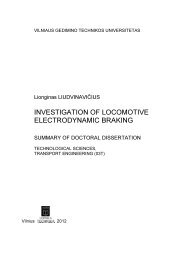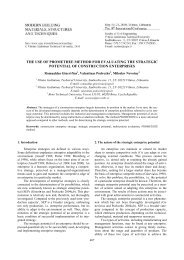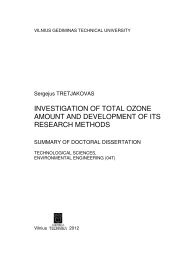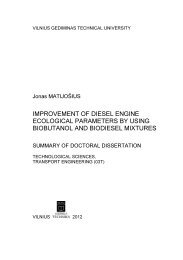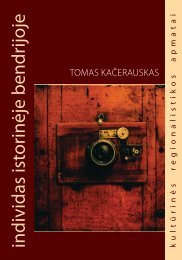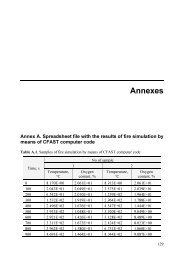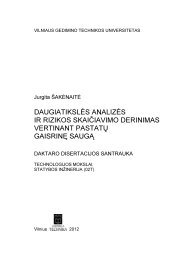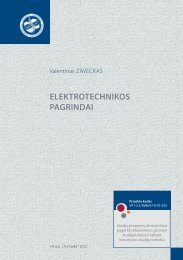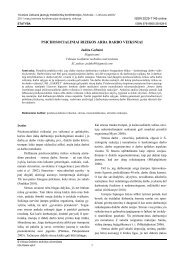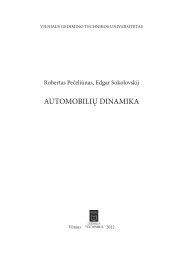significance of creative competitions to lithuanian art of architecture
significance of creative competitions to lithuanian art of architecture
significance of creative competitions to lithuanian art of architecture
Create successful ePaper yourself
Turn your PDF publications into a flip-book with our unique Google optimized e-Paper software.
VILNIUS GEDIMINAS TECHNICAL UNIVERSITY<br />
Darius LINARTAS<br />
SIGNIFICANCE OF CREATIVE<br />
COMPETITIONS TO LITHUANIAN ART<br />
OF ARCHITECTURE<br />
SUMMARY OF DOCTORAL DISSERTATION<br />
HUMANITIES,<br />
HISTORY AND THEORY OF ARTS (03H),<br />
SCULPURE AND ARCHITECTURE (H312)<br />
Vilnius 2011
Doc<strong>to</strong>ral dissertation was prepared at Vilnius Gediminas Technical University<br />
in 2007–2011.<br />
Scientific Supervisor<br />
Pr<strong>of</strong> Dr Rimantas BUIVYDAS (Vilnius Gediminas Technical<br />
University, Humanities, His<strong>to</strong>ry and Theory <strong>of</strong> Arts – 03H).<br />
The dissertation is being defended at the Council <strong>of</strong> Scientific Field <strong>of</strong><br />
His<strong>to</strong>ry and Theory <strong>of</strong> Arts at Vilnius Gediminas Technical University:<br />
Chairman<br />
Pr<strong>of</strong> Dr Habil Konstantinas JAKOVLEVAS-MATECKIS (Vilnius<br />
Gediminas Technical University, Humanities, His<strong>to</strong>ry and Theory <strong>of</strong> Arts<br />
– 03H).<br />
Members:<br />
Pr<strong>of</strong> Dr Petras GRECEVIČIUS (Klaipėda Universitety, Humanities,<br />
His<strong>to</strong>ry and Theory <strong>of</strong> Arts – 03H),<br />
Assoc Pr<strong>of</strong> Dr Jūratė JUREVIČIENĖ (Vilnius Gediminas Technical<br />
University, Humanities, His<strong>to</strong>ry and Theory <strong>of</strong> Arts – 03H),<br />
Assoc Pr<strong>of</strong> Dr Kęstutis LUPEIKIS (Gediminas Technical University,<br />
Humanities, His<strong>to</strong>ry and Theory <strong>of</strong> Arts – 03H),<br />
Assoc Pr<strong>of</strong> Dr Kęstutis ZALECKIS (Kaunas University <strong>of</strong> Technology,<br />
Humanities, His<strong>to</strong>ry and Theory <strong>of</strong> Arts – 03H).<br />
Opponents:<br />
Pr<strong>of</strong> Dr Algimantas MAČIULIS (Vilnius Academy <strong>of</strong> Arts, Humanities,<br />
His<strong>to</strong>ry and Theory <strong>of</strong> Arts – 03H),<br />
Assoc Pr<strong>of</strong> Dr Almantas Liudas SAMALAVIČIUS (Vilnius Gediminas<br />
Technical University, Humanities, His<strong>to</strong>ry and Theory <strong>of</strong> Arts – 03H).<br />
The dissertation will be defended at the public meeting <strong>of</strong> the Council <strong>of</strong><br />
Scientific Field <strong>of</strong> His<strong>to</strong>ry and Theory <strong>of</strong> Arts in the Senate Hall <strong>of</strong> Vilnius<br />
Gediminas Technical University at 10 a. m. on 15 December 2011.<br />
Address: Saulėtekio al. 11, LT-10223 Vilnius, Lithuania.<br />
Tel.: +370 5 274 4952, +370 5 274 4956; fax +370 5 270 0112;<br />
e-mail: dok<strong>to</strong>r@vgtu.lt<br />
The summary <strong>of</strong> the doc<strong>to</strong>ral dissertation was distributed on 14 November<br />
2011.<br />
A copy <strong>of</strong> the doc<strong>to</strong>ral dissertation is available for review at the Library <strong>of</strong><br />
Vilnius Gediminas Technical University (Saulėtekio al. 14, LT-10223 Vilnius,<br />
Lithuania).<br />
© Darius Lin<strong>art</strong>as, 2011
VILNIAUS GEDIMINO TECHNIKOS UNIVERSITETAS<br />
Darius LINARTAS<br />
KŪRYBINIŲ KONKURSŲ REIKŠMĖ<br />
LIETUVOS ARCHITEKTŪROS MENE<br />
DAKTARO DISERTACIJOS SANTRAUKA<br />
HUMANITARINIAI MOKSLAI,<br />
MENOTYRA (03H),<br />
SKULPTŪRA IR ARCHITEKTŪRA (H312)<br />
Vilnius 2011
Disertacija rengta 2007–2011 metais Vilniaus Gedimino technikos universitete.<br />
Mokslinis vadovas<br />
pr<strong>of</strong>. habil. dr. Rimantas BUIVYDAS (Vilniaus Gedimino technikos<br />
universitetas, humanitariniai mokslai, menotyra– 03H).<br />
Disertacija ginama Vilniaus Gedimino technikos universite<strong>to</strong> Menotyros<br />
mokslo krypties taryboje:<br />
Pirmininkas<br />
pr<strong>of</strong>. habil. dr. Konstantinas JAKOVLEVAS-MATECKIS (Vilniaus<br />
Gedimino technikos universitetas, humanitariniai mokslai, menotyra –<br />
03H).<br />
Nariai:<br />
pr<strong>of</strong>. dr. Petras GRECEVIČIUS (Klaipėdos universitetas,<br />
humanitariniai mokslai, menotyra – 03H),<br />
doc. dr. Jūratė JUREVIČIENĖ (Vilniaus Gedimino technikos<br />
universitetas, humanitariniai mokslai, menotyra – 03H),<br />
doc. dr. Kęstutis LUPEIKIS (Vilniaus Gedimino technikos universitetas,<br />
humanitariniai mokslai, menotyra – 03H),<br />
doc. dr. Kęstutis ZALECKIS (Kauno technologijos universitetas,<br />
humanitariniai mokslai, menotyra – 03H).<br />
Oponentai:<br />
pr<strong>of</strong>. dr. Algimantas MAČIULIS (Vilniaus dailės akademija,<br />
humanitariniai mokslai, menotyra – 03H),<br />
doc. dr. Almantas Liudas SAMALAVIČIUS (Vilniaus Gedimino<br />
technikos universitetas, humanitariniai mokslai, menotyra – 03H).<br />
Disertacija bus ginama viešame Menotyros mokslo krypties tarybos posėdyje<br />
2011 m. gruodžio 15 d. 10 val. Vilniaus Gedimino technikos universite<strong>to</strong><br />
sena<strong>to</strong> posėdžių salėje.<br />
Adresas: Saulėtekio al. 11, LT-10223 Vilnius, Lietuva.<br />
Tel.: (8 5) 274 4952, (8 5) 274 4956; faksas (8 5) 270 0112;<br />
el. paštas dok<strong>to</strong>r@vgtu.lt<br />
Disertacijos santrauka išsiuntinėta 2011 m. lapkričio 14 d.<br />
Disertaciją galima peržiūrėti Vilniaus Gedimino technikos universite<strong>to</strong><br />
bibliotekoje (Saulėtekio al. 14, LT-10223 Vilnius, Lietuva).<br />
VGTU leidyklos „Technika“ 1932-M mokslo literatūros knyga.<br />
© Darius Lin<strong>art</strong>as, 2011
Introduction<br />
Topicality <strong>of</strong> the Problem. About one fifth <strong>of</strong> the national product in<br />
Lithuania is generated by the construction sec<strong>to</strong>r. Thus <strong>architecture</strong> makes an<br />
influence on how rationally some one fifth <strong>of</strong> the state property will be used.<br />
High quality <strong>architecture</strong> represents the state, shapes up the environment and a<br />
human being. Creative <strong>competitions</strong> have been recognized on the international<br />
level as the best way <strong>to</strong> achieve high quality <strong>architecture</strong> under conditions <strong>of</strong><br />
democratic society. The theme <strong>of</strong> <strong>creative</strong> <strong>competitions</strong> is relevant, however,<br />
not only in economic, pr<strong>of</strong>essional architectural, but also social sense. Where a<br />
competition is held in a full-fledged manner, it becomes a specific contract <strong>of</strong><br />
civic consonance, as versatile opinions may be thus expressed and consolidated<br />
opinion by commissioners, pr<strong>of</strong>essionals, society representatives and other<br />
stakeholders is generated. In this respect, nothing better than a competition has<br />
so far been invented. This is the medium, where contemporary <strong>architecture</strong> stars<br />
are born and pr<strong>of</strong>essional qualifications <strong>of</strong> p<strong>art</strong>icipating architects are raised.<br />
Such racing could be also found in other <strong>art</strong>s, but it has been recognized that in<br />
<strong>architecture</strong> the competition has exclusive and multisided <strong>significance</strong>.<br />
By making analysis <strong>of</strong> <strong>creative</strong> <strong>competitions</strong> in Lithuania, their goals and<br />
types, models <strong>of</strong> existence, also comparing them <strong>to</strong> analogous processes abroad,<br />
we can discern some regularities, analyze not only positive, but also negative<br />
experiences. The research underlying the basis <strong>of</strong> this dissertation allows for<br />
identifying and evaluating the <strong>significance</strong> <strong>of</strong> <strong>creative</strong> <strong>competitions</strong> held <strong>to</strong> the<br />
<strong>art</strong> <strong>of</strong> <strong>architecture</strong> in Lithuania and foreseeing some theoretical improvement<br />
models for future system <strong>of</strong> <strong>competitions</strong>.<br />
Background <strong>of</strong> the Research. The subject <strong>of</strong> <strong>creative</strong> <strong>competitions</strong> has<br />
been explored in Western architecturology, but not <strong>to</strong>o explicitly. According <strong>to</strong><br />
the level <strong>of</strong> analysis and summarizing, publications on this subject may be<br />
divided in<strong>to</strong> the following categories:<br />
a) <strong>of</strong> fragmentary character:<br />
– publication on p<strong>art</strong>icular <strong>competitions</strong>;<br />
– publication on p<strong>art</strong>icular aspects <strong>of</strong> architectural <strong>competitions</strong>;<br />
b) <strong>of</strong> explicit character:<br />
– <strong>competitions</strong>’ reviews and collections;<br />
– scientific analytical treaties.<br />
The last group showing the scientific relevance <strong>of</strong> the subject is the<br />
sparsest. There are a few reviewing collections on foreign architectural<br />
<strong>competitions</strong> <strong>of</strong> greater <strong>significance</strong>. Hilde de Haan and Ids Haagsma in their<br />
1987 book Architects in Competition describe 59 design projects <strong>of</strong> 14<br />
5
architectural <strong>competitions</strong> within the last 200 years. Two volume collection<br />
Architectural Competitions by Benedikt Taschen publishers 1995 presents the<br />
material <strong>of</strong> 48 <strong>competitions</strong> held from 1792 <strong>to</strong> 1993. These publications have<br />
more cognitive character and do not contain any analysis or summaries <strong>of</strong><br />
architectural <strong>competitions</strong>.<br />
One <strong>of</strong> the treatises with deeper and more scientific approach is Design<br />
Competitions by P. D. Spreiregen (1979). The author described and illustrated<br />
over 90 <strong>competitions</strong>, compiled a chronological table <strong>of</strong> more than 800 <strong>creative</strong><br />
<strong>competitions</strong> st<strong>art</strong>ing from 448 B.C. <strong>to</strong> 1977 A.D., discussed the theoretical<br />
background <strong>of</strong> such <strong>competitions</strong> (their context, purposes, false public attitudes,<br />
competition, typology), analyzed the competition practice in USA (advantages<br />
and disadvantages, “mechanics” <strong>of</strong> <strong>competitions</strong>, specific examples and<br />
experiments in this area), and also supplied his recommendations for<br />
organization <strong>of</strong> <strong>competitions</strong> and preparation <strong>of</strong> their requirements.<br />
Jack L. Nasar, the Pr<strong>of</strong>essor <strong>of</strong> the University <strong>of</strong> Ohio, presents an<br />
exclusively critical approach <strong>to</strong> competition practice in his book Design by<br />
Competition: Making Design Competition Work (1999). Based on operational<br />
shortcomings <strong>of</strong> a few objects implemented by the way <strong>of</strong> <strong>competitions</strong>,<br />
analyzing the differences <strong>of</strong> public and pr<strong>of</strong>essionals’ opinions, the author seeks<br />
<strong>to</strong> disclose the imperfection <strong>of</strong> the competition system. Due <strong>to</strong> such approach<br />
the material presented in the book is perceived as <strong>to</strong>o single-sided, failing <strong>to</strong><br />
disclose the entire variety <strong>of</strong> the competition system.<br />
Lithuania lacks more explicit scientific research on architectural<br />
<strong>competitions</strong> in our country. Such Lithuanian authors as A. Ambrasas, R.<br />
Buivydas, R. Leitanaitė, D. Lin<strong>art</strong>as, L. Vaitys, A. Žickis have published<br />
<strong>art</strong>icles on separate <strong>competitions</strong> or quite narrow areas in relation <strong>to</strong> this<br />
subject. Article Architektūros projektų konkursai (Architectural Design<br />
Competitions) published 1996 in the pr<strong>of</strong>essional magazine Archiforma<br />
analyzed the problems <strong>of</strong> preparation <strong>of</strong> the competition requirements <strong>of</strong> the<br />
time. G. Čaikauskas in his <strong>art</strong>icle Konkursas – susibėgimas ar susidūrimas (A<br />
Competition. Is It a Gathering or Confrontation) 1999 described the<br />
peculiarities <strong>of</strong> preparation <strong>of</strong> <strong>creative</strong> <strong>competitions</strong> as exposed <strong>to</strong> the changing<br />
market conditions. Competitions were mentioned in a few texts, not related<br />
directly <strong>to</strong> the subject. For example, J. Kančienė in her <strong>art</strong>icle Lietuvos<br />
architektų orientyrai tarpukaryje (Landmarks <strong>of</strong> Lithuanian Architects in the<br />
Interwar Period) 1996 described a number <strong>of</strong> <strong>competitions</strong> organized in<br />
Lithuania, 1918–1940.<br />
Based on the existing researches, we can state that the subject <strong>of</strong><br />
architectural <strong>competitions</strong> in Lithuania still has been little analyzed<br />
scientifically, and the information collected is fragmented, non-systematized,<br />
6
lacking broader and deeper theoretical analysis. Foreign architecturology<br />
researches on the subject <strong>of</strong> <strong>competitions</strong> may be applied only in p<strong>art</strong>, as they<br />
require certain selection, up-dating and adaptation <strong>to</strong> Lithuanian conditions.<br />
Subject Matter and Boundaries <strong>of</strong> the Research. The subject matter <strong>of</strong> the<br />
research is architectural <strong>competitions</strong> in Lithuania <strong>to</strong> begin with their origin<br />
(end <strong>of</strong> the 18th century) up <strong>to</strong> the present times (2010). The work analyzes the<br />
his<strong>to</strong>ry, purposes and meaning <strong>of</strong> <strong>creative</strong> <strong>competitions</strong>, peculiarities <strong>of</strong> their<br />
arrangement and place <strong>of</strong> society in this process. For broader understanding <strong>of</strong><br />
the research subject, the dissertation author applies analyses <strong>of</strong> analogous or<br />
simultaneous foreign processes and cases <strong>of</strong> Lithuanian architects’ p<strong>art</strong>icipation<br />
at international <strong>competitions</strong>. The research is focused not only on the facts and<br />
course <strong>of</strong> the previous <strong>competitions</strong>, but also on their causality, compliance <strong>of</strong><br />
results with the purposes, further existence <strong>of</strong> design projects selected by the<br />
way <strong>of</strong> <strong>creative</strong> <strong>competitions</strong> and improvement in organization <strong>of</strong> <strong>competitions</strong>.<br />
The dissertation is not aimed at exploration and s<strong>to</strong>cktaking <strong>of</strong> all<br />
architectural <strong>competitions</strong> and design projects in Lithuania, distinction and<br />
disclosure <strong>of</strong> their all possible types and organizational peculiarities. The<br />
research has fragments <strong>of</strong> already possessed information being collected,<br />
systematized, classified and summarized, in order <strong>to</strong> make this a theoretical<br />
background for further researches and deepen the knowledge in narrower<br />
aspects <strong>of</strong> architectural competition practice, set a benchmark for the areas <strong>to</strong> be<br />
improved. The basis for this research is architectural <strong>competitions</strong> in Lithuania<br />
Any his<strong>to</strong>ry, practice and theory <strong>of</strong> foreign <strong>competitions</strong> have been used only in<br />
so far as it is needed for understanding, comparison and taking over the<br />
experience <strong>of</strong> the system’s genesis.<br />
Objective and Tasks <strong>of</strong> the Research. The dissertation aims at disclosing<br />
the <strong>significance</strong> <strong>of</strong> architectural <strong>competitions</strong> <strong>to</strong> <strong>art</strong> <strong>of</strong> <strong>architecture</strong> in Lithuania,<br />
improvement <strong>of</strong> architects’ pr<strong>of</strong>essional excellence and public meaning <strong>of</strong><br />
competitive selection, as well as analyzing the preconditions for improvement<br />
<strong>of</strong> the competition system.<br />
To achieve the objective <strong>of</strong> the work, the following tasks have been raised<br />
and formulated:<br />
1. To explore the genesis <strong>of</strong> architectural <strong>competitions</strong> and review the<br />
his<strong>to</strong>rical development <strong>of</strong> architectural <strong>competitions</strong> in Lithuania<br />
st<strong>art</strong>ing from its origins <strong>to</strong> the present day.<br />
7
2. Based on specific examples <strong>of</strong> architectural <strong>competitions</strong> in Lithuania,<br />
<strong>to</strong> analyze the main types <strong>of</strong> <strong>competitions</strong> and their purposes, disclose<br />
their peculiarities and meaning.<br />
3. To perform the critical analysis on organization process <strong>of</strong><br />
architectural <strong>competitions</strong> in Lithuania (preparation <strong>of</strong> requirements,<br />
rules, involvement <strong>of</strong> society <strong>to</strong> the design process and evaluation) and<br />
further existence and quality <strong>of</strong> the competition winning design<br />
projects.<br />
4. To disclose the peculiarities <strong>of</strong> public, architectural and pr<strong>of</strong>essional<br />
<strong>significance</strong> <strong>of</strong> <strong>creative</strong> <strong>competitions</strong>.<br />
Methodology <strong>of</strong> Research. The work should be ascribed <strong>to</strong> the<br />
interdisciplinary research area. The genesis and development <strong>of</strong> architectural<br />
<strong>competitions</strong> have been explored with the help <strong>of</strong> his<strong>to</strong>rical method. By<br />
application <strong>of</strong> systemic analysis, architectural <strong>competitions</strong> have been analyzed<br />
as an integral p<strong>art</strong> <strong>of</strong> the designing process and also the social – cultural life.<br />
The comparative analysis has been invoked <strong>to</strong> disclose the experiences <strong>of</strong><br />
Lithuanian and foreign architectural <strong>competitions</strong>, key types, peculiarities and<br />
models <strong>of</strong> existence <strong>of</strong> such <strong>competitions</strong>. The compliance <strong>of</strong> competition<br />
results with their purposes has been compared and preconditions for the<br />
competition system’s improvement suggested with the help <strong>of</strong> analytical-critical<br />
method. The research has been based on selection and analysis <strong>of</strong> pr<strong>of</strong>essional<br />
literature by Lithuanian and foreign authors, collection <strong>of</strong> visual material,<br />
archival explorations and generalization and classification <strong>of</strong> the collected<br />
material.<br />
Scientific Novelty and Practical Value. The work has reviewed <strong>creative</strong><br />
<strong>competitions</strong> in a scope broader than a separate competition, his<strong>to</strong>rical period or<br />
problematic issue for the first time in Lithuanian architecturology. The analysis<br />
<strong>of</strong> development <strong>of</strong> Lithuanian architectural <strong>competitions</strong> has been performed<br />
st<strong>art</strong>ing from its origins up <strong>to</strong> the present times. Based on such analysis, the<br />
chronological table <strong>of</strong> major <strong>creative</strong> <strong>competitions</strong> has been compiled. The<br />
typology, organizational peculiarities and models <strong>of</strong> existence <strong>of</strong> Lithuanian<br />
<strong>competitions</strong> have been summarized. Taking the research as a basis, the<br />
<strong>significance</strong> <strong>of</strong> <strong>creative</strong> <strong>competitions</strong> as an independent form <strong>of</strong> dissemination<br />
<strong>of</strong> architectural thought <strong>to</strong> Lithuanian <strong>art</strong> <strong>of</strong> <strong>architecture</strong> and possible trends for<br />
their improvement have been summarized. The material <strong>of</strong> the research forms<br />
the generalized theoretical background for further exploration <strong>of</strong> the subject <strong>of</strong><br />
architectural <strong>competitions</strong> in narrower, more concrete scientific aspects. In<br />
8
addition <strong>to</strong> this, the disclosed theoretical preconditions for improvement <strong>of</strong> the<br />
competition system may provide assistance <strong>to</strong> organizers <strong>of</strong> architectural<br />
<strong>competitions</strong> in Lithuania for improvement <strong>of</strong> conditions, rules and<br />
requirements <strong>of</strong> <strong>creative</strong> <strong>competitions</strong>, development <strong>of</strong> more effective models<br />
<strong>of</strong> this system.<br />
Defended Propositions<br />
1. As a democratic form <strong>of</strong> selection <strong>of</strong> <strong>art</strong>istic ideas, <strong>creative</strong><br />
<strong>competitions</strong> are homological p<strong>art</strong> <strong>of</strong> cultural, political and economic<br />
life hyperbolically representing his<strong>to</strong>rical and typological peculiarities<br />
<strong>of</strong> architectural development in Lithuania.<br />
2. The prevailing trend <strong>of</strong> representative aspirations in Lithuanian<br />
<strong>competitions</strong> reveals traditional understanding <strong>of</strong> their purpose with<br />
underused other possibilities <strong>of</strong> <strong>creative</strong> <strong>competitions</strong>, such as meeting<br />
utilitarian needs, instilling innovations and search for alternative<br />
<strong>art</strong>istic ideas.<br />
3. Improvement preconditions <strong>of</strong> <strong>competitions</strong> in Lithuania underlie in<br />
appropriate implementation <strong>of</strong> the state policy in architectural sec<strong>to</strong>r<br />
alongside with raising the efficiency <strong>of</strong> competition organization itself<br />
– improvement <strong>of</strong> conditions, requirements and evaluation process,<br />
and search for more diverse involvement <strong>of</strong> society.<br />
4. One <strong>of</strong> the most relevant advantages <strong>of</strong> competition phenomenon in<br />
Lithuania still remains the great opportunities <strong>of</strong> <strong>creative</strong> independence<br />
provided by it and saving symbolic <strong>art</strong>istic capital for p<strong>art</strong>icipating<br />
architects.<br />
5. Significance <strong>of</strong> <strong>creative</strong> <strong>competitions</strong> in Lithuania is revealed through<br />
objects <strong>of</strong> public recognition selected in such <strong>competitions</strong> and<br />
implemented, Lithuanian architectural <strong>art</strong> examples and heritage <strong>of</strong> a<br />
certain period, growth <strong>of</strong> architects’ excellence, finding new talents<br />
and presentation <strong>of</strong> innovative ideas.<br />
Scope <strong>of</strong> the Work is 198 pages, including appendices; 143 illustrations<br />
and 4 tables are also presented. The author has used 208 literature sources while<br />
writing the present dissertation.<br />
1. His<strong>to</strong>rical Development Analysis <strong>of</strong> Architectural Competitions in<br />
Lithuania<br />
1.1. Competitions by the end <strong>of</strong> the 18 th century. First facts <strong>of</strong><br />
architectural <strong>competitions</strong> were described in Ancient Greece (the 5th c. BC),<br />
9
st<strong>art</strong>ed practicing again in the period <strong>of</strong> Italian Renaissance (15th c. AD), and<br />
were first applied in Lithuania by the end <strong>of</strong> the 18th century.<br />
Facts <strong>of</strong> <strong>competitions</strong> won by Laurynas Stuoka-Gucevičius – for<br />
reconstruction design projects <strong>of</strong> Vilnius Cathedral (1777) and Town Hall<br />
(1784) – were a progressive phenomenon in his<strong>to</strong>ry <strong>of</strong> not only Lithuanian, but<br />
also international <strong>competitions</strong>. This coincided with the <strong>to</strong>tal progress <strong>of</strong> the<br />
country, both in architectural and political aspects, timely entrenchment in<br />
Lithuania <strong>of</strong> the style <strong>of</strong> Classicism that was dominant in Western Europe at the<br />
time, as well as one <strong>of</strong> the first constitutions in the world ratified by the State <strong>of</strong><br />
Polish-Lithuanian Commonwealth.<br />
1.2. Competitions in the Czarist Period, 1795–1917. Within the period<br />
<strong>of</strong> Czarist regime, Lithuania saw by far less architectural design <strong>competitions</strong><br />
than held in Western Europe or even other terri<strong>to</strong>ries <strong>of</strong> Russia at that time.<br />
Relating this fact <strong>to</strong> the political and cultural genocide <strong>of</strong> Lithuania<br />
implemented by the Russian government, a conclusion may be drawn that the<br />
lack <strong>of</strong> architectural <strong>competitions</strong> is one <strong>of</strong> the attributes <strong>of</strong> civic restrictions<br />
and insufficient democracy.<br />
1.3. Competitions in Lithuania, 1918–1940. One <strong>of</strong> the most important<br />
peculiarities <strong>of</strong> independent Lithuania within the interwar period was the fact<br />
that design <strong>competitions</strong> had become an integral p<strong>art</strong> in architectural life and<br />
one <strong>of</strong> the essential fac<strong>to</strong>rs determining the quality <strong>of</strong> <strong>architecture</strong> and<br />
pr<strong>of</strong>essional improvement <strong>of</strong> architects <strong>of</strong> the time. Abundant number <strong>of</strong><br />
<strong>creative</strong> <strong>competitions</strong> for public objects organized during the interwar period<br />
showed a purposeful architectural policy <strong>of</strong> Lithuanian government <strong>of</strong> the time<br />
and aspirations <strong>to</strong> represent as best as possible the young republic on the<br />
international as well as national scale with the use <strong>of</strong> natural authority <strong>of</strong><br />
<strong>architecture</strong>.<br />
1.4. Soviet Time Competitions, 1940–1989. In order <strong>to</strong> fulfill the criteria<br />
<strong>of</strong> the declared values, fictitious soviet democracy was forced <strong>to</strong> organize not<br />
only political elections, but also <strong>creative</strong> <strong>competitions</strong>. Although quite a low<br />
number <strong>of</strong> such organized <strong>competitions</strong> and implemented competitive design<br />
projects inadequate <strong>to</strong> the massive scale <strong>of</strong> construction revealed the quality <strong>of</strong><br />
<strong>architecture</strong> being not a priority area in general cases. Only politically and<br />
ideologically significant objects had made an exception. P<strong>art</strong>icipation in<br />
<strong>competitions</strong> for soviet time architects was the only possibility <strong>to</strong> escape the<br />
routine <strong>of</strong> planned design, normative as well as ideological control and seek for<br />
the heights <strong>of</strong> <strong>art</strong>istic excellence. Pr<strong>of</strong>essional skills gained by architects in such<br />
<strong>competitions</strong> had had a positive impact on the general level <strong>of</strong> <strong>architecture</strong> in<br />
Lithuania, both in soviet and later periods.<br />
10
1.5 Competitions in Contemporary Lithuania, 1990–2010. National<br />
rebirth and political, socioeconomic and cultural transformations within the first<br />
decade <strong>of</strong> regained independence (1990–2000) invoked the growth in number<br />
<strong>of</strong> architectural <strong>competitions</strong>, especially those that were forbidden or restricted<br />
in soviet times (<strong>of</strong> religious and cultural objects). Unfortunately, such<br />
<strong>competitions</strong> inherited ineffective soviet competition organization models,<br />
absolutely unfit for market conditions.<br />
The quantity analysis <strong>of</strong> the <strong>competitions</strong> (1990–2010) shows the general<br />
growth tendency, both in number <strong>of</strong> <strong>competitions</strong> (their popularity) and number<br />
<strong>of</strong> objects implemented according <strong>to</strong> the competition design projects<br />
(efficiency). As the comparative weight <strong>of</strong> commercial objects increases within<br />
the <strong>to</strong>tal number <strong>of</strong> <strong>creative</strong> <strong>competitions</strong>, the lack <strong>of</strong> <strong>competitions</strong> for public<br />
and cultural objects is quite alarming, because it reflects insufficient attention <strong>to</strong><br />
architectural quality <strong>of</strong> buildings constructed out <strong>of</strong> the state budget funds.<br />
Within the second decade <strong>of</strong> independence (2000–2010), still growing<br />
p<strong>art</strong>icipation <strong>of</strong> Lithuanian architects in <strong>competitions</strong> and their success in<br />
foreign <strong>creative</strong> <strong>competitions</strong> show Lithuania’s improving integration in<strong>to</strong><br />
global architectural processes and capability <strong>to</strong> generate competitive<br />
architectural ideas, not just on the Lithuanian, but also international scale.<br />
Grown prize funds <strong>of</strong> Lithuanian <strong>competitions</strong> allow for treating them as<br />
international level <strong>competitions</strong>, setting higher requirements <strong>to</strong> their organizers<br />
and revealing defects in competition requirements.<br />
2. Essential Types and Purposes <strong>of</strong> Architectural Competitions<br />
2.1. Typological Structure <strong>of</strong> Architectural Competitions. Despite quite<br />
versatile typology <strong>of</strong> architectural <strong>competitions</strong> and possibility <strong>to</strong> classify such<br />
<strong>creative</strong> contests according <strong>to</strong> their object, content, stages, implementation<br />
method, operation terri<strong>to</strong>ry, p<strong>art</strong>icipants’ teams, the recent guidelines by the<br />
International Union <strong>of</strong> Architects (UIA) and UNESCO, and regulations for<br />
architectural <strong>competitions</strong> issued by the Architects’ Council <strong>of</strong> Europe (ACE)<br />
suggest the simplified classification <strong>of</strong> <strong>competitions</strong> according <strong>to</strong> their purpose<br />
– <strong>of</strong> design or idea; according <strong>to</strong> the mode <strong>of</strong> p<strong>art</strong>icipation – open or restricted,<br />
and according <strong>to</strong> the form <strong>of</strong> implementation – <strong>of</strong> one or several stages. Within<br />
the framework <strong>of</strong> European and global integration, any terri<strong>to</strong>rial classification,<br />
such as internal, municipal, district, regional or national – has simply lost its<br />
meaning.<br />
Whereas many typological models <strong>of</strong> competition classification are<br />
essentially based on their organizational peculiarities or processes, the <strong>art</strong><br />
criticism-based analysis finds the competition classification according <strong>to</strong> their<br />
11
key objectives and aspirations more meaningful – representational, utilitarian,<br />
instilling innovations or <strong>of</strong> search for alternative <strong>art</strong>istic ideas.<br />
2.2. Competition as a Form <strong>of</strong> Satisfying Representational Aspirations.<br />
Representative aspirations are one <strong>of</strong> the oldest and most traditional causes for<br />
calling the competition and al<strong>to</strong>gether an outstanding precondition for creation<br />
<strong>of</strong> architectural works. The course <strong>of</strong> <strong>creative</strong> competition itself not only<br />
defines the architectural expression <strong>of</strong> the future object, but also is its initial<br />
public representation, which is as much important. It is noteworthy that the<br />
exclusive dominance <strong>of</strong> representative aspirations in contemporary Lithuanian<br />
<strong>competitions</strong> shows a certain backwardness <strong>of</strong> <strong>creative</strong> <strong>competitions</strong> in our<br />
country in comparison <strong>to</strong> Western Europe and USA, where the motives and<br />
forms <strong>of</strong> <strong>competitions</strong> have become fairly varied within the recent 50 years.<br />
In the last decade’s (2000–2010) <strong>competitions</strong> in Lithuania, a general trend<br />
<strong>of</strong> growing representative aspirations in <strong>competitions</strong> for commercial objects,<br />
which usually do not take the representative function, is observed. The interwar<br />
tradition (1918–1940) <strong>to</strong> st<strong>art</strong> designing important public objects with<br />
architectural <strong>competitions</strong> is, however, lost. The <strong>architecture</strong> <strong>of</strong> pavilions for<br />
international exhibitions, which is one <strong>of</strong> the most important fac<strong>to</strong>rs <strong>of</strong><br />
international visualization <strong>of</strong> our country, also could be named as one <strong>of</strong> the<br />
most problematic <strong>of</strong> <strong>competitions</strong> for representative objects in Lithuania.<br />
2.3. Competition as Implementation <strong>of</strong> Utilitarian Needs. Utilitarian<br />
aspirations occurred in the process <strong>of</strong> a competition becoming a usual, mundane<br />
event corresponding <strong>to</strong> the prevailing real and practical needs in the general<br />
spectrum <strong>of</strong> <strong>architecture</strong>. A group <strong>of</strong> utilitarian buildings has always – and<br />
especially within the last decade (2000–2010) – been the key formant <strong>of</strong> the<br />
cityscape shaping the “face” <strong>of</strong> Lithuanian cities. Therefore <strong>competitions</strong> are a<br />
significant link capable <strong>of</strong> regulation <strong>of</strong> this process. Although, due <strong>to</strong> the<br />
growing financial capacities <strong>of</strong> commercial commissioners, the subjects dealt<br />
with in the utilitarian <strong>competitions</strong> within the recent period have expanded in<strong>to</strong><br />
the regeneration, conversion or development issues <strong>of</strong> the entire city blocks or<br />
complexes, but such practical aspirations have st<strong>art</strong>ed <strong>to</strong> reflect certain<br />
mercantile or even expansive tendencies. The fact that within the second decade<br />
following our regained independence (2000–2010) exclusively commercial<br />
rather than publicly financed objects have prevailed in the category <strong>of</strong> utilitarian<br />
<strong>creative</strong> <strong>competitions</strong> shows the shortage <strong>of</strong> understanding <strong>of</strong> <strong>significance</strong> <strong>of</strong><br />
high quality <strong>architecture</strong> on the state level. This has been manifested through<br />
inappropriate application <strong>of</strong> the Law on Public Procurement with exclusive<br />
anonymous <strong>competitions</strong> <strong>to</strong> purchase design services rather than fully-fledged<br />
design <strong>competitions</strong> being carried out.<br />
12
2.4. Competition as Means for Instilling Innovations. Instilling<br />
innovations means intellectual goals <strong>of</strong> the competition, not necessarily<br />
obtaining a tangible form, or peculiarities manifested in the competition<br />
process. According <strong>to</strong> their character, innovations may be <strong>art</strong>istic or<br />
technological. Expecting innovations, special <strong>competitions</strong> are announced, but<br />
innovative solutions may also come up in the process <strong>of</strong> any competition. The<br />
fact that Lithuania has the least number <strong>of</strong> <strong>competitions</strong> inspired by this motive<br />
shows insufficient understanding <strong>of</strong> their <strong>significance</strong> <strong>to</strong> intellectual and<br />
<strong>creative</strong> progress.<br />
2.5. Competition as Contest for Alternative Creative Ideas. The form <strong>of</strong><br />
<strong>competitions</strong> for alternative ideas means the inspiration <strong>of</strong> the <strong>creative</strong> process<br />
itself, without seeking for any practical goals. The meaning <strong>of</strong> such or similar<br />
<strong>competitions</strong> is indirect: <strong>to</strong> encourage and develop <strong>creative</strong> personalities. A<br />
need for such alternative idea <strong>competitions</strong> occurred in the process <strong>of</strong><br />
development and getting more complicated <strong>of</strong> the issues <strong>to</strong> be solved, as well as<br />
the concept <strong>of</strong> the competition itself. Idea <strong>competitions</strong> have been st<strong>art</strong>ed <strong>to</strong><br />
announce in cases <strong>of</strong> complicated circumstances, when the necessity, purpose,<br />
final parameters or location <strong>of</strong> the designed object were unknown, when<br />
implementation <strong>of</strong> the design was able <strong>to</strong> continue for a long time or be held in<br />
separate stages. In Lithuania such <strong>competitions</strong> are sometimes organized within<br />
the general frameworks <strong>of</strong> design projects for landscape, <strong>to</strong>wn planning or<br />
larger urban structures, although they have <strong>to</strong> be applied in all cases, where the<br />
land plot detailed layout is absent or being replaced, i.e. when the essential<br />
object parameters have not still been fixed.<br />
3. Theoretical Preconditions for Improvement <strong>of</strong> Architectural<br />
Competitions in Lithuania<br />
3.1. Competition Conditions, Rules and Requirements. Rules and<br />
essential principles for preparation <strong>of</strong> conditions for <strong>competitions</strong> organized by<br />
the Lithuanian Architects’ Union as applicable <strong>to</strong>day are in compliance with the<br />
guidelines issued by the International Union <strong>of</strong> Architects (UIA) and<br />
Architects’ Council <strong>of</strong> Europe (ACE), but an excess attention <strong>to</strong> legal and<br />
qualification requirements should be noticed in the structure <strong>of</strong> the conditions,<br />
thus losing the key goal <strong>of</strong> the competition – the search for the best architectural<br />
idea. The essential negative fac<strong>to</strong>r having an impact on the procedure <strong>of</strong><br />
architectural <strong>competitions</strong> for the state financed objects within the recent<br />
decade (2000–2010) has been faulty application <strong>of</strong> the Law on Public<br />
Procurement, which falls behind the common European practice, – the selection<br />
<strong>of</strong> the work in the idea competition in accordance with the price criteria rather<br />
than the quality, insufficient time for preparation <strong>of</strong> the competition proposals,<br />
13
merging the procedures <strong>of</strong> contrac<strong>to</strong>r and architect’s selection in<strong>to</strong> one and thus<br />
arising possibilities <strong>of</strong> manipulation with competition results. Incomprehensive<br />
statement, ambiguity and nonconformity with competition purpose, design task<br />
and evaluation criteria, absence <strong>of</strong> the p<strong>art</strong>ies’ liability may be specified as<br />
essential procedural deficiencies in Lithuanian competition conditions.<br />
Improvement preconditions for competition requirements would be the<br />
following: clear formulation <strong>of</strong> the design task, separation <strong>of</strong> compulsory and<br />
recommended requirements, simplification <strong>of</strong> qualification restrictions, and<br />
increasing the competition organizer’s responsibility, concreteness <strong>of</strong> the<br />
procedure and delegation <strong>of</strong> duties.<br />
3.2. Evaluation Institution <strong>of</strong> Competition Designs. The role <strong>of</strong> the jury<br />
is always critical for the competition results, but in Lithuania it still can be<br />
observed the insufficient focus on selection <strong>of</strong> the evaluation commission’s<br />
members, who must be compliant with the principles <strong>of</strong> pr<strong>of</strong>essional<br />
knowledge, equal representation <strong>of</strong> public and private interests, in selection <strong>of</strong><br />
the commission’s working methods, keeping <strong>to</strong> the set evaluation criteria,<br />
responsibility and accountability before the p<strong>art</strong>icipants, commissioner and<br />
society. Key directions for improvement <strong>of</strong> the jury’s work efficiency should be<br />
broader use <strong>of</strong> reviewers, experts and consultants’ services, giving appropriate<br />
time corresponding <strong>to</strong> the number <strong>of</strong> works presented for the competition for<br />
their review and discussions, signing the equity declaration, and public<br />
accountability for the motives <strong>of</strong> all competition works. Such accountability<br />
would obligate the jury members <strong>to</strong> analyze each work more precisely, help <strong>to</strong><br />
find more individual peculiarities in each design project, have the <strong>art</strong>istic<br />
excellence improvement <strong>significance</strong> <strong>to</strong> the competition p<strong>art</strong>icipants, and<br />
increase the transparency <strong>of</strong> the jury’s work and at the same time – society’s<br />
trust in the entire competition system.<br />
3.3. Public Involvement in the Competition Process. Judging in the light<br />
<strong>of</strong> the international democracy development trends, the society’s involvement<br />
in the process <strong>of</strong> <strong>creative</strong> <strong>competitions</strong> in Lithuania is so far insufficient and<br />
based on the principle <strong>of</strong> notification only: decide – announce – defend. The<br />
most meaningful possibilities for discussing actions with society would be in<br />
the competition planning and its requirements’ preparation stages. Essential is<br />
also involvement <strong>of</strong> the members <strong>of</strong> society in<strong>to</strong> the jury, as well as approbation<br />
<strong>of</strong> results with supply <strong>of</strong> the final report in the form <strong>of</strong> a post-competition<br />
exhibition, catalogue or simply the jury’s report.<br />
3.4. Implementation Inconsistencies <strong>of</strong> Winning Design Projects. One<br />
problem, very characteristic in Lithuania, causes real trouble: <strong>to</strong> modify and<br />
completely redesign the design projects in the stage <strong>of</strong> construction thus turning<br />
in<strong>to</strong> void the most appropriate principle for selection <strong>of</strong> the best solution. The<br />
14
most effective way <strong>to</strong> change this vicious post-competition stage is <strong>to</strong> modify<br />
the administrative or legal procedure with the focus on protection <strong>of</strong> not only<br />
the author, but also the competition’s rights as being the best way <strong>to</strong> approve<br />
the most appropriate idea solutions.<br />
Large number <strong>of</strong> unimplemented design projects is determined by the<br />
competition system itself – it represents the underused complex <strong>of</strong> pr<strong>of</strong>essional<br />
ideas and solutions, where a huge potential <strong>of</strong> useful information is hidden.<br />
Seeking for more effective use <strong>of</strong> this information, it should be collected,<br />
structured according <strong>to</strong> the needs <strong>of</strong> possible users’ groups and publicly<br />
available.<br />
3.5. Influence <strong>of</strong> Creative Competitions <strong>to</strong> Development <strong>of</strong> Art <strong>of</strong><br />
Architecture. In difference from representatives <strong>of</strong> other <strong>art</strong>s, architects<br />
consciously seek for <strong>creative</strong> <strong>competitions</strong> by acknowledging and criticizing<br />
their quality, which equals <strong>to</strong> a lottery. Quite disproportionate ratio between the<br />
p<strong>art</strong>icipants’ efforts and unguaranteed probability <strong>of</strong> benefit may be explained<br />
by the fact that <strong>creative</strong> <strong>competitions</strong> is an exclusive <strong>art</strong>istic field, in which<br />
architects as nowhere else may become relatively au<strong>to</strong>nomous crea<strong>to</strong>rs<br />
independent from any political and economic situation or the commissioner’s<br />
influence. P<strong>art</strong>icipation at <strong>creative</strong> <strong>competitions</strong> is a certain method for saving<br />
the symbolic <strong>art</strong>istic capital for p<strong>art</strong>icipating architects helping them <strong>to</strong> gain<br />
higher position not only in the competition, but also in their pr<strong>of</strong>essional<br />
practice and at the same time use the authority and skills gained in the<br />
<strong>competitions</strong> in their real works.<br />
The meaning <strong>of</strong> <strong>creative</strong> <strong>competitions</strong> in Lithuania rests on the publicly<br />
recognized objects selected and implemented through such <strong>competitions</strong>,<br />
examples and heritage <strong>of</strong> Lithuanian architectural <strong>art</strong> <strong>of</strong> a certain period,<br />
growing excellence <strong>of</strong> architects themselves, discovery <strong>of</strong> new talents and<br />
instilling innovative ideas.<br />
General Conclusions<br />
1. Any qualitative and quantitative uplifts in the his<strong>to</strong>ry <strong>of</strong> architectural<br />
<strong>competitions</strong> in Lithuania (the end <strong>of</strong> the 18 th century, the interwar period<br />
(1918-40), period after regained independence in 1990–2011), as well as abroad<br />
(e.g. Ancient Greece and Renaissance) have always coincided with positive<br />
democratic changes in society – this testifies the integrity <strong>of</strong> political, economic<br />
and <strong>art</strong>istic life, in which <strong>competitions</strong> become a certain landmark for<br />
democracy and <strong>creative</strong> progress.<br />
2. The his<strong>to</strong>rical development peculiarities <strong>of</strong> <strong>competitions</strong> in Lithuania have<br />
been analogous <strong>to</strong> other countries with deep traditions in this area, but<br />
15
according <strong>to</strong> certain features – the prevalence <strong>of</strong> representative aspirations,<br />
romanticized understanding <strong>of</strong> an architect’s role in this process – the recent<br />
two decades (1990–2010) <strong>of</strong> competition development in Lithuania may be<br />
identified with similar processes in Europe present in the middle <strong>of</strong> the 20 th<br />
century. Such backwardness <strong>of</strong> the competition system development in<br />
Lithuania may be explained by the interruptions and restrictions in the tradition<br />
<strong>of</strong> free <strong>creative</strong> competition in our country by the Czarist regime (1795–1917)<br />
and soviet occupation (1940–1990). On the other hand, the rapid changes in the<br />
Lithuanian competition system within the recent two decades signify great<br />
possibilities for improvement <strong>of</strong> the system <strong>of</strong> <strong>creative</strong> <strong>competitions</strong>.<br />
3. The tw<strong>of</strong>old <strong>significance</strong> <strong>of</strong> <strong>creative</strong> <strong>competitions</strong> <strong>to</strong> the <strong>art</strong> <strong>of</strong> <strong>architecture</strong><br />
in Lithuania may be distinguished – the direct-tangible and indirect. The<br />
tangible meaning <strong>of</strong> <strong>creative</strong> <strong>competitions</strong> is represented by publicly recognized<br />
objects, selected and implemented through such <strong>competitions</strong>, which are<br />
considered the examples and heritage <strong>of</strong> Lithuanian <strong>art</strong> <strong>of</strong> <strong>architecture</strong> <strong>of</strong> a<br />
certain period. Indirect <strong>significance</strong> <strong>of</strong> <strong>competitions</strong> is manifested through the<br />
p<strong>art</strong>icipating architects’ growing excellence, discovery <strong>of</strong> new talents, instilling<br />
and dissemination <strong>of</strong> innovative ideas, promotion <strong>of</strong> progress <strong>of</strong> <strong>creative</strong><br />
thought and involvement <strong>of</strong> society in<strong>to</strong> the designing processes.<br />
4. Architectural <strong>competitions</strong> are an exclusive <strong>art</strong>istic field, where architects<br />
as nowhere else can act as au<strong>to</strong>nomous crea<strong>to</strong>rs, relatively independent from the<br />
commissioner, political and economic situation. In Lithuania this degree <strong>of</strong><br />
independence provided by <strong>creative</strong> <strong>competitions</strong> gained a special importance in<br />
soviet times, but has still remained <strong>of</strong> paramount importance up <strong>to</strong> the present<br />
day.<br />
5. Architectural competition is a traditional form <strong>of</strong> rivalry for <strong>art</strong>istic ideas.<br />
The compliance <strong>of</strong> the competition results with its purposes disclose the quality<br />
<strong>of</strong> the given competition, helps <strong>to</strong> solve problems, identify them according <strong>to</strong><br />
the time period, typological or target groups <strong>of</strong> <strong>competitions</strong>. As in any other<br />
model <strong>of</strong> activity, the competition’s vitality is inspired by reconsideration <strong>of</strong> its<br />
scheme forcing us <strong>to</strong> redefine the influence boundaries, character and meaning<br />
<strong>of</strong> this phenomenon.<br />
6. Essential problems <strong>of</strong> <strong>competitions</strong> in Lithuania and preconditions for their<br />
improvement may be distinguished as external and internal. The external<br />
preconditions are the sphere regulated by the state policy and legislation. Key<br />
problems in this area are the following: lack <strong>of</strong> laws regulating the issues<br />
related <strong>to</strong> the need for <strong>competitions</strong> and implementation <strong>of</strong> their results,<br />
inappropriate application <strong>of</strong> the Law on Public Procurement, insufficient<br />
attention <strong>to</strong> the state representative objects. The internal preconditions for<br />
competition improvement are as follows: raising the organizational efficiency<br />
16
<strong>of</strong> <strong>competitions</strong>, including the improvement <strong>of</strong> their conditions, selection <strong>of</strong><br />
appropriate jury and competition system, involvement <strong>of</strong> society, publication,<br />
collection, analysis and use <strong>of</strong> information.<br />
7. The research analysis <strong>of</strong> <strong>competitions</strong> as a unique <strong>creative</strong> phenomenon<br />
has disclosed their special importance <strong>to</strong> the Lithuanian <strong>art</strong> <strong>of</strong> <strong>architecture</strong> in<br />
different his<strong>to</strong>rical periods, <strong>to</strong> key typological groups <strong>of</strong> buildings,<br />
implementation <strong>of</strong> representative and utilitarian design projects, instilling<br />
innovations and looking for alternative design solutions, developing architects’<br />
pr<strong>of</strong>essional and <strong>art</strong>istic excellence, saving the symbolic <strong>art</strong>istic and<br />
informational capital even under unfavorable social, economic and political<br />
conditions. Due <strong>to</strong> these reasons, the influence <strong>of</strong> <strong>creative</strong> <strong>competitions</strong> <strong>to</strong> the<br />
Lithuanian <strong>art</strong> <strong>of</strong> <strong>architecture</strong> will further remain huge, and competition quality<br />
will basically determine the global changes in Lithuanian <strong>architecture</strong> and its<br />
spheres <strong>of</strong> influence in the future.<br />
List <strong>of</strong> Published Works on the Topic <strong>of</strong> the Dissertation<br />
In the Reviewed Scientific Periodical Publications<br />
Lin<strong>art</strong>as, D. 2009a. Lietuvos architektūrinių konkursų tendencijos 1999–2009 metais,<br />
Urbanistika ir architektūra t. 33 (priedas): 323–336. ISSN 1392–1630. (EBSCO,<br />
ICONDA, CSA).<br />
Lin<strong>art</strong>as, D. 2009b. Sovietinio laikotarpio architektūros konkursų raidos apžvalga,<br />
Urbanistika ir architektūra 33(1): 39–47. ISSN 1392–1630. (EBSCO, ICONDA, CSA).<br />
Lin<strong>art</strong>as, D. 2009c. Nepanaudo<strong>to</strong>s neįgyvendintų projektų galimybės, Mokslas –<br />
Lietuvos ateitis 2009 1(2): 53–56. ISSN 2029–2341. (INDEX COPERNICUS).<br />
Lin<strong>art</strong>as, D. 2010a. Esminės reprezentacinių siekų įgyvendinimo architektūros<br />
konkursuose formos ir tendencijos, Mokslas – Lietuvos ateitis 2010 2(3): 24–30. ISSN<br />
2029–2341. (INDEX COPERNICUS, ICONDA, EBSCO, GALE, ULRICH’S).<br />
In the other Editions<br />
Lin<strong>art</strong>as, D. 2007. Architektūros konkursų ir Valstybės architektūros politikos sąveika, iš<br />
K. Šešelgio skaitymai – 2007. Rokiškis, 2007 m. balandžio 26–27 d. Vilnius: Technika,<br />
93–99. ISBN 978-9955-28-116-0.<br />
Lin<strong>art</strong>as, D. 2008. Architektūros konkursai praeityje: is<strong>to</strong>rija ar aktualios pamokos, iš K.<br />
Šešelgio skaitymai – 2008. Rokiškis, 2008 m. gegužės 8–9 d. Vilnius: Technika, 102–<br />
110. ISBN 978-9955-28-266-2.<br />
17
About the Author<br />
Darius Lin<strong>art</strong>as was born on 5 February 1972, in Vilnius. In 1995 he<br />
received the Bachelor’s degree in <strong>architecture</strong>, the Faculty <strong>of</strong> Architecture,<br />
Vilnius Gediminas’ Technical University. In 1997 he was conferred the<br />
Master’s degree in <strong>architecture</strong>, at the same faculty. In 2007–2011 Darius<br />
Lin<strong>art</strong>as continued his post-graduate studies seeking for the Doc<strong>to</strong>r’s degree at<br />
the Dep<strong>art</strong>ment <strong>of</strong> Architectural Fundamentals and Theory, Vilnius Gediminas’<br />
Technical University. Since 1995 he works as an architect in Vilniaus<br />
Archprojektas, UAB. Within the period <strong>of</strong> 2000–2009, he p<strong>art</strong>icipated at five<br />
architectural <strong>competitions</strong> being a prizeman at four <strong>of</strong> them. Throughout 1996–<br />
2005 be collaborated in pr<strong>of</strong>essional architectural press, namely the Archiforma,<br />
Arkitektas and Statybų Pilotas publishing about 40 <strong>art</strong>icles in them. Darius<br />
Lin<strong>art</strong>as is a member <strong>of</strong> the Lithuanian Architects’ Union since 1999, and also a<br />
member <strong>of</strong> the work group formed at the Council <strong>of</strong> the Lithuanian Architects’<br />
Union for improvement <strong>of</strong> regulations for architectural <strong>competitions</strong>. In 1997–<br />
2007 he taught at the Dep<strong>art</strong>ment <strong>of</strong> Architectural Graphics, Vilnius<br />
Gediminas’ Technical University. Presently, he is a lecturer at the Dep<strong>art</strong>ment<br />
<strong>of</strong> Architecture, the same University.<br />
KŪRYBINIŲ KONKURSŲ REIKŠMĖ LIETUVOS<br />
ARCHITEKTŪROS MENE<br />
Mokslo problemos aktualumas. Apie vieną penktadalį nacionalinio<br />
produk<strong>to</strong> Lietuvoje sukuria statybos sek<strong>to</strong>rius. Taigi architektūra turi įtakos<br />
tam, kaip racionaliai bus panaudota maždaug penktadalis valstybės tur<strong>to</strong>.<br />
Kokybiška architektūra reprezentuoja valstybę, formuoja aplinką ir žmogų.<br />
Tarptautiniu mastu pripažinta: geriausias būdas demokratinės visuomenės<br />
sąlygomis siekti architektūros kokybės – kūrybiniai konkursai. Tačiau konkursų<br />
tema svarbi ne tik ekonominiu, pr<strong>of</strong>esiniu architektūriniu, bet taip pat ir<br />
visuomeniniu požiūriu. Jei konkursas vyksta visavertiškai, jis tampa savotiška<br />
visuomeninės santarvės sut<strong>art</strong>imi: išsakomos įvairiausios nuomonės,<br />
sugeneruojama konsoliduota užsakovų, pr<strong>of</strong>esionalų, visuomenės ats<strong>to</strong>vų,<br />
priimančių sprendimą asmenų nuomonė. Šiuo požiūriu nieko geresnio už<br />
konkursą dar nėra sugalvota. Tai terpė, kurioje gimsta šiuolaikinės architektūros<br />
žvaigždės, gerėja jose dalyvaujančių architektų pr<strong>of</strong>esiniai įgūdžiai. Varžytuvės<br />
būdingos ir ki<strong>to</strong>ms meno šakoms, tačiau pripažįstama, kad architektūroje jų<br />
reikšmė išskirtinė ir daugialypė.<br />
Nagrinėdami Lietuvos kūrybinių konkursų raidą, tikslus ir tipus, būties<br />
modelius, lygindami juos su analogiškais procesais užsienyje, galime įžvelgti<br />
18
dėsningumus, analizuoti ne tik teigiamas, bet ir neigiamas jų patirtis. Atliktas<br />
tyrimas leidžia nustatyti ir apibendrinti įvykusių kūrybinių konkursų reikšmę<br />
Lietuvos architektūros menui ir numatyti teorinius ateities konkursų sistemos<br />
<strong>to</strong>bulinimo modelius.<br />
Problemos ištirtumas. Kūrybinių konkursų tema Vakarų<br />
architektūrologijoje nagrinėta, bet ne plačiai. Publikacijas šia tema pagal<br />
analizės ir apibendrinimo lygį galima suskirstyti į kelias grupes:<br />
a) fragmentinio pobūdžio:<br />
– publikacijos apie atskirus konkursus;<br />
– publikacijos apie kuriuos nors architektūros konkursų aspektus;<br />
b) plataus pobūdžio:<br />
– konkursų apžvalgos-rinkiniai;<br />
– moksliniai analitiniai veikalai.<br />
Pastarųjų, rodančių mokslinį temos ištirtumą, yra mažiausiai. Esama kele<strong>to</strong><br />
apžvalginių rinkinių apie reikšmingesnius užsienio architektūros konkursus.<br />
Hilde de Haan ir Ids Haagsma 1987-aisiais knygoje „Architects in<br />
Competition“ išsamiai aprašyti 59 projektai iš 14 architektūros konkursų per<br />
pastaruosius 200 metų. „Benedikt Taschen“ leidyklos dviejų dalių 1995-ųjų<br />
metų rinkinyje „Architectural Competitions“ pateikta 48 konkursų nuo 1792 iki<br />
1993 m. medžiaga. Šie leidiniai daugiau pažintinio pobūdžio, juose nėra<br />
architektūros konkursų reiškinio analizės ar apibendrinimų.<br />
Vienas iš moksliškiau ir nuodugniau temą nagrinėjančių veikalų yra P. D.<br />
Spreiregen 1979 m. knyga „Design <strong>competitions</strong>“. Au<strong>to</strong>rius ne tik aprašė ir<br />
iliustravo daugiau nei 90 konkursų, sudarė daugiau nei 800 kūrybinių<br />
varžytuvių nuo 448 m. pr. Kr. iki 1977 m. chronologinę lentelę, bet taip pat<br />
aptarė konkursų teorinį „pagrindą“ (kontekstą, tikslus, klaidingas visuomenės<br />
nuostatas, konkurenciją, tipologiją), analizavo JAV konkursinę praktiką<br />
(privalumus ir trūkumus, konkursų „mechaniką“, konkrečius pavyzdžius ir<br />
eksperimentus šioje srityje), pateikė rekomendacijų konkursų organizavimui,<br />
sąlygų rengimui.<br />
Ohajo universite<strong>to</strong> pr<strong>of</strong>esorius Jack L. Nasar 1999 m. knygoje „Design by<br />
competition: Making design competition work“ konkursų praktiką nagrinėja<br />
pabrėžtinai kritiniu požiūriu. Remdamasis kele<strong>to</strong> konkurso būdu įgyvendintų<br />
objektų eksploatacijos trūkumais, analizuodamas visuomenės ir pr<strong>of</strong>esionalų<br />
nuomonių skirtumus, au<strong>to</strong>rius siekia atskleisti konkursų sistemos ne<strong>to</strong>bulumą.<br />
Būtent dėl <strong>to</strong> knygoje surinkta medžiaga tampa per daug vienpusiška,<br />
neatskleidžia visos konkursų sistemos įvairovės.<br />
Platesnių mokslo tyrimų apie Lietuvos architektūros konkursus nėra.<br />
Lietuvių au<strong>to</strong>riai A. Ambrasas, R. Buivydas, R. Leitanaitė, D. Lin<strong>art</strong>as, L.<br />
19
Vaitys, A. Žickis yra rašę apie atskirus konkursus ar siauras su šia tema<br />
susijusias sritis. Pr<strong>of</strong>esiniame leidinyje „Archiforma“ 1996 m. publikuotame A.<br />
Žickio straipsnyje „Architektūros projektų konkursai“ nagrinėta tuometė<br />
konkursų sąlygų rengimo problematika, G. Čaikauskas 1999 m. straipsnyje<br />
„Konkursas – susibėgimas ar susidūrimas“ aprašė kūrybinių varžytuvių<br />
organizavimo kintančiomis rinkos sąlygomis ypatumus. Konkursai epizodiškai<br />
minimi tekstuose, tiesiogiai neskirtuose šiai temai. Pvz., J. Kančienė 1996 m.<br />
straipsnyje „Lietuvos architektų orientyrai tarpukaryje“ aprašė keletą konkursų,<br />
surengtų Lietuvoje 1918–1940 m. laikotarpiu.<br />
Remdamiesi turimais tyrimais, galime teigti, kad Lietuvos architektūros<br />
konkursų tema moksliškai mažai nagrinėta, informacija fragmentiška,<br />
nesusisteminta, trūksta platesnės ir gilesnės teorinės analizės. Užsienio<br />
architektūrologijos tyrimai konkursų tema gali būti pritaikomi tik iš dalies, nes<br />
reikalauja atrankos, aktualizacijos ir adaptacijos Lietuvos sąlygoms.<br />
Tyrimų objektas ir tyrimų ribos. Darbo tyrimų objektas – architektūros<br />
konkursai Lietuvoje nuo ištakų (XVIII a. pabaigos) iki šių laikų (2010 m.).<br />
Nagrinėjama kūrybinių varžytuvių is<strong>to</strong>rija, tikslai, tipologija, prasmė,<br />
organizavimo ypatumai, visuomenės vieta šiame procese. Platesniam tiriamojo<br />
objek<strong>to</strong> supratimui disertacijoje analizuojami ir analogiški ar tuo laikotarpiu<br />
užsienyje vykę procesai bei Lietuvos architektų dalyvavimas tarptautiniuose<br />
konkursuose. Tyrime susitelkiama ne tik į įvykusių konkursų faktus ir eigą, bet<br />
ir į priežastingumus, rezultatų atitikimą tikslams, <strong>to</strong>lesnę kūrybinių varžytuvių<br />
būdu atrinktų projektų būtį, konkursų organizavimo <strong>to</strong>bulinimą.<br />
Disertacijoje nesiekiama ištirti ir inven<strong>to</strong>rizuoti visų Lietuvos architektūros<br />
konkursų ir projektų, išskirti ir atskleisti visų įmanomų jų tipų, organizavimo<br />
ypatumų. Moksliniame darbe sukaupti, susisteminti, klasifikuoti ir apibendrinti<br />
jau turimos informacijos fragmentai, kad tai taptų teoriniu pagrindu <strong>to</strong>lesniems<br />
tyrimams ir žinių gilinimui siauresniais architektūros konkursų praktikos<br />
aspektais, nužymėtų gaires sričių, kurios galėtų būti <strong>to</strong>bulinamos. Tyrimo<br />
pagrindas – Lietuvos architektūros konkursai. Užsienio konkursų is<strong>to</strong>rija,<br />
praktika ir teorija apžvelgiama tiek, kiek <strong>to</strong> reikia suprasti sistemos genezei,<br />
palyginti ir perimti patirčiai.<br />
Darbo tikslas ir uždaviniai. Šio darbo tikslas yra atskleisti architektūros<br />
konkursų reikšmę Lietuvos architektūros menui ir architektų pr<strong>of</strong>esinio<br />
meistriškumo augimui, visuomeninę konkursinės atrankos prasmę, išnagrinėti<br />
konkursų sistemos <strong>to</strong>bulinimo prielaidas. Siekiant įgyvendinti darbo tikslą<br />
iškelti ir suformuluoti šie uždaviniai:<br />
20
1. Ištirti architektūros konkursų genezę, apžvelgti Lietuvos architektūros<br />
konkursų is<strong>to</strong>rinę raidą nuo jų atsiradimo iki šių dienų.<br />
2. Remiantis konkrečiais Lietuvos architektūros konkursų pavyzdžiais,<br />
išanalizuoti pagrindinius konkursų tipus ir tikslus, atskleisti jų ypatumus ir<br />
prasmę.<br />
3. Atlikti Lietuvos architektūros konkursų organizavimo (sąlygų rengimo,<br />
nuostatų, visuomenės įtraukimo į projektavimo procesą, vertinimo) bei<br />
konkursuose laimėjusių projektų būties ir kokybės kritinę analizę.<br />
4. Atskleisti kūrybinių konkursų visuomeninės, architektūrinės ir pr<strong>of</strong>esinės<br />
reikšmės Lietuvoje ypatybes.<br />
Tyrimų me<strong>to</strong>dika. Darbas priskiriamas tarpdisciplininių tyrimų sričiai.<br />
Taikant is<strong>to</strong>rinį me<strong>to</strong>dą tirta architektūros konkursų genezė, raida.<br />
Architektūros konkursai, taikant sisteminę analizę, nagrinėti kaip integrali<br />
projektavimo proceso, k<strong>art</strong>u ir visuomeninio kultūrinio gyvenimo dalis.<br />
Lyginamosios analizės būdu atskleista Lietuvos ir užsienio patirtis, pagrindiniai<br />
architektūros konkursų tipai, ypatumai, būties modeliai. Analitiniu-kritiniu<br />
me<strong>to</strong>du lyginamas konkursų rezultatų atitikimas jų tikslams, siūlomos konkursų<br />
sistemos <strong>to</strong>bulinimo prielaidos. Tyrimai paremti Lietuvos ir užsienio au<strong>to</strong>rių<br />
specialiosios literatūros atranka ir analize, vaizdinės medžiagos kaupimu,<br />
archyviniais tyrinėjimais, surink<strong>to</strong>s medžiagos apibendrinimu, klasifikacija.<br />
Mokslinis naujumas ir praktinė vertė. Pirmą k<strong>art</strong>ą Lietuvos<br />
architektūrologijoje kūrybiniai konkursai apžvelgti platesniu nei pavienio<br />
konkurso, is<strong>to</strong>rinio tarpsnio ar problemos požiūriu. Atlikta is<strong>to</strong>rinė Lietuvos<br />
architektūros konkursų raidos analizė nuo ištakų iki šių laikų, jos pagrindu<br />
sudaryta svarbesnių kūrybinių varžytuvių chronologinė lentelė. Apibendrinta<br />
Lietuvos konkursų tipologija, organizavimo ypatumai, būties modeliai. Atlik<strong>to</strong><br />
tyrimo pagrindu apibendrinta kūrybinių konkursų, kaip savarankiškos<br />
architektūrinės minties sklaidos formos, reikšmė Lietuvos architektūros mene,<br />
galimos <strong>to</strong>bulinimo kryptys. Šio tyrimo medžiaga sukuria apibendrintą teorinį<br />
pagrindą, leidžiantį <strong>to</strong>liau nagrinėti architektūros konkursų temą siauresniais,<br />
labiau sukonkretintais moksliniais aspektais. Taip pat atskleis<strong>to</strong>s teorinės<br />
konkursų sistemos <strong>to</strong>bulinimo prielaidos gali padėti Lietuvos architektūros<br />
konkursų organiza<strong>to</strong>riams gerinti kūrybinių konkursų sąlygas, nuostatus,<br />
reikalavimus, kurti efektyvesnius šios sistemos modelius.<br />
Ginamieji teiginiai<br />
1. Kūrybiniai konkursai kaip demokratinė meninių idėjų atrankos forma yra<br />
homologiška kultūrinio, politinio ir ekonominio gyvenimo dalis,<br />
21
hiperbolizuotai atskleidžianti is<strong>to</strong>rinius ir tipologinius Lietuvos<br />
architektūros raidos ypatumus.<br />
2. Reprezentacinių siekių vyravimo Lietuvos konkursuose tendencija rodo<br />
tradicionalistinę jų paskirties sampratą, nepakankamai išnaudojant kitas<br />
kūrybinių varžytuvių teikiamas galimybes – utilitarių reikmių tenkinimą,<br />
inovacijų teigimą, alternatyvių meninių idėjų paiešką.<br />
3. Šalies konkursų <strong>to</strong>bulinimo prielaidos slypi tinkamai vykdomoje valstybės<br />
politikoje architektūros sek<strong>to</strong>riuje, k<strong>art</strong>u su konkursų organizavimo<br />
efektyvumo didinimu – sąlygų, nuostatų, reikalavimų, vertinimo<br />
<strong>to</strong>bulinimu, įvairesnių visuomenės įtraukimo formų paieška.<br />
4. Vienu aktualiausių konkursų reiškinio Lietuvoje privalumų lieka didelės<br />
juose dalyvaujančių architektų kūrybinio savarankiškumo ir simbolinio<br />
meninio kapitalo kaupimo galimybės.<br />
5. Kūrybinių konkursų reikšmę Lietuvoje įprasmina juose išrinkti ir<br />
įgyvendinti visuotinai pripažinti objektai, tam tikro laikotarpio Lietuvos<br />
architektūros meno pavyzdžiai ir paveldas, architektų meistriškumo<br />
augimas, naujų talentų atskleidimas, inovatyvių idėjų iškėlimas.<br />
Darbo struktūra. Disertaciją sudaro įvadas, trys skyriai, bendrosios<br />
išvados, naudo<strong>to</strong>s literatūros ir au<strong>to</strong>riaus publikacijų disertacijos tema sąrašai,<br />
iliustracijų sąrašas bei du priedai.<br />
Įvadiniame skyriuje aptariamas darbo aktualumas, problemos ištirtumas,<br />
atliekama su tema susijusios literatūros analizė, aprašomas tyrimų objektas,<br />
formuluojamas darbo tikslas bei uždaviniai, aprašoma tyrimų me<strong>to</strong>dika, darbo<br />
mokslinis naujumas, reikšmė, ginamieji teiginiai. Įvado pabaigoje prista<strong>to</strong>mos<br />
disertacijos tema au<strong>to</strong>riaus paskelb<strong>to</strong>s publikacijos ir pranešimai konferencijose<br />
bei disertacijos struktūra.<br />
Pirmame disertacijos skyriuje analizuojamas kūrybinio konkurso reiškinio<br />
atsiradimas, is<strong>to</strong>rinė vystymosi raida Lietuvoje nuo XVIII a. pabaigos iki šių<br />
laikų (2010 m.), įvardijamos tam tikrų laikotarpių būdingos tendencijos.<br />
Antrame disertacijos skyriuje tiriama kūrybinių konkursų tipologinė<br />
struktūra, Lietuvos konkursų visuma klasifikuojama ir charakterizuojama pagal<br />
vyraujančius siekius: reprezentacinius, utilitariuosius, novacijų teigimo,<br />
alternatyvių idėjų varžytuvių.<br />
Trečiajame disertacijos skyriuje analizuojamos teorinės konkursų<br />
<strong>to</strong>bulinimo prielaidos: sąlygos, nuostatai, reikalavimai, projektų vertin<strong>to</strong>jų<br />
institutas, visuomenės dalyvavimo problematika, laimėjusių konkursus projektų<br />
įgyvendinimo prieštaringumai, kūrybinių konkursų įtaka Lietuvos meno raidai.<br />
22
Kiekvienas skyrius apibendrinamas atskirai. Darbo pabaigoje pateikiamos<br />
tyrimo rezultatais grįs<strong>to</strong>s išvados, naudo<strong>to</strong>s literatūros, au<strong>to</strong>riaus publikacijų<br />
disertacijos tema sąrašai, priedai.<br />
Darbo apimtis – 198 puslapiai, įskaitant priedus; tekste panaudoti 143<br />
paveikslai, 3 lentelės. Rašant disertaciją remtasi 208 literatūros šaltiniais.<br />
Bendrosios išvados<br />
1. Kiekybiniai ir kokybiniai pakilimai architektūros konkursų is<strong>to</strong>rijoje tiek<br />
Lietuvoje (XVIII a. pabaiga, tarpukaris: 1918–1940, nepriklausomybės<br />
atkūrimas: 1990–2011), tiek užsienyje (Senovės Graikija, Renesansas)<br />
sutapdavo su teigiamais demokratiniais poslinkiais visuomenėje – tai rodo<br />
politinio, ekonominio ir meninio gyvenimo integralumą, jame konkursai tampa<br />
savotišku demokratijos ir meninės pažangos požymiu.<br />
2. Lietuvos konkursų is<strong>to</strong>rinės raidos ypatumai analogiški gilias tradicijas<br />
šioje srityje turėjusioms šalims, tačiau pagal tam tikrus bruožus –<br />
reprezentacinių siekių vyravimą, romantizuotą architek<strong>to</strong> vaidmens šiame<br />
procese suvokimą – pastaruosius du dešimtmečius (1990–2010) Lietuvoje<br />
galime tapatinti su panašiais procesais, vykusiais Europoje praėjusio amžiaus<br />
viduryje. Šį Lietuvos konkursinės sistemos raidos atsilikimą galima paaiškinti<br />
laisvos kūrybinės konkurencijos tradicijos pertraukimu ir suvaržymais carinio<br />
režimo (1795–1917) bei sovietinės okupacijos (1940–1990) laikotarpiais. Kita<br />
vertus, pastarųjų dviejų dešimtmečių Lietuvos konkursų sistemos pokyčių<br />
tempas teikia didelių kūrybinių varžytuvių <strong>to</strong>bulinimo galimybių.<br />
3. Kūrybinių konkursų reikšmę Lietuvos architektūros menui galima skirti į<br />
tiesioginę materialią ir netiesioginę. Materialus kūrybinių konkursų<br />
įprasminimas – juose išrinkti ir įgyvendinti visuotinai pripažinti objektai – tam<br />
tikro laikotarpio Lietuvos architektūros meno pavyzdžiai ir paveldas.<br />
Netiesioginė konkursų prasmė – architektų meninio meistriškumo augimas,<br />
naujų talentų atskleidimas, inovatyvių idėjų iškėlimas, sklaida, kūrybinės<br />
minties pažangos skatinimas, plačiosios visuomenės įtraukimas į projektavimo<br />
procesus.<br />
4. Architektūros konkursai – tai išskirtinis meninis laukas, kuriame kaip<br />
niekur kitur architektai gali tapti savarankiškais kūrėjais, santykinai<br />
nepriklausomais nuo užsakovo dikta<strong>to</strong>, politinės ir ekonominės padėties.<br />
Lietuvoje šis kūrybinių konkursų teikiamas savarankiškumo laipsnis<br />
nepaprastai svarbus tapo sovietiniais metais, tačiau išlieka vienas svarbiausių ir<br />
šiandien.<br />
5. Architektūros konkursai – tradicinė meninių idėjų konkurencijos forma.<br />
Konkurso rezultatų atitikimas iškeltiems tikslams atskleidžia konkurso kokybę,<br />
23
padeda išsiaiškinti problemas, identifikuoti jas pagal laikmetį, tipologines ar<br />
tikslines konkursų grupes. Kaip ir kiekvieno modelio veiklai, konkursams<br />
gyvybingumo įkvepia jų schemos permąstymas, verčiantis nuolat iš naujo<br />
nustatyti šios veiklos fenomeno įtakos ribas, pobūdį ir reikšmę.<br />
6. Esminės Lietuvos konkursų problemos ir <strong>to</strong>bulinimo prielaidos yra<br />
išorinės ir vidinės. Išorinės – tai valstybės politikos ir įstatymų reguliuojama<br />
sfera. Esminės šios srities problemos: konkursų būtinumo ir rezultatų<br />
įgyvendinimo klausimus reglamentuojančių įstatymų nebuvimas, ydingas<br />
Viešųjų pirkimų įstatymo taikymas, nepakankamas dėmesys valstybiniams,<br />
reprezentaciniams objektams. Vidinės konkursų <strong>to</strong>bulinimo prielaidos – paties<br />
konkurso organizavimo efektyvumo didinimas: sąlygų <strong>to</strong>bulinimas, tinkamos<br />
vertinimo komisijos ir sistemos parinkimas, visuomenės įtraukimas, viešinimas,<br />
informacijos kaupimas, analizavimas ir panaudojimas.<br />
7. Konkursų kaip unikalaus kūrybos reiškinio nagrinėjimas atskleidė ypatingą<br />
jų svarbą Lietuvos architektūros menui tiek įvairiais is<strong>to</strong>riniais periodais, tiek<br />
esminėms tipologinėms pastatų grupėms, įgyvendinant ir reprezentacinius, ir<br />
utilitarius poreikius, teigiant inovacijas bei ieškant projektų sprendinių<br />
alternatyvų, ugdant architektų meninį meistriškumą, kaupiant simbolinį meninį<br />
ir informacinį kapitalą, net nepalankiomis socialinėmis, ekonominėmis ir<br />
politinėmis sąlygomis. Dėl šių priežasčių kūrybinių varžytuvių įtaka Lietuvos<br />
architektūros menui ir <strong>to</strong>liau išliks didelė, o jų kokybė nemaža dalimi lems<br />
globalius šalies architektūros ir jos įtakos sferų pokyčius ateityje.<br />
Trumpos žinios apie au<strong>to</strong>rių<br />
Darius Lin<strong>art</strong>as gimė 1972 m. vasario 5 d. Vilniuje. Vilniaus Gedimino<br />
technikos universite<strong>to</strong> Architektūros fakultete 1995 m. įgijo architektūros<br />
bakalauro laipsnį; 1997 m. ten pat – architektūros magistro laipsnį. 2007–2011<br />
m. – Vilniaus Gedimino technikos universite<strong>to</strong> Architektūros pagrindų ir<br />
teorijos katedros dok<strong>to</strong>rantas. Nuo 1995 m. dirba architektu UAB „Vilniaus<br />
archprojektas“. 2000–2009 m. dalyvavo penkiuose architektūros konkursuose,<br />
keturiuose iš jų tapo prizininku. 1996–2005 m. bendradarbiavo su pr<strong>of</strong>esiniais<br />
architektūros leidiniais „Archiforma“, „Arkitektas“, „Statybų pilotas“, juose<br />
išspausdino apie 40 straipsnių. Nuo 1999 m. Lietuvos architektų sąjungos narys.<br />
2011 m. – Lietuvos architektų sąjungos tarybos sudary<strong>to</strong>s darbo grupės LAS<br />
architektūrinių konkursų nuostatų <strong>to</strong>bulinimui narys. 1997–2007 m. dėstė<br />
Vilniaus Gedimino technikos universite<strong>to</strong> Architektūrinės grafikos katedroje.<br />
Šiuo metu dirba lek<strong>to</strong>riumi Vilniaus Gedimino technikos universite<strong>to</strong><br />
Architektūros katedroje.<br />
24



